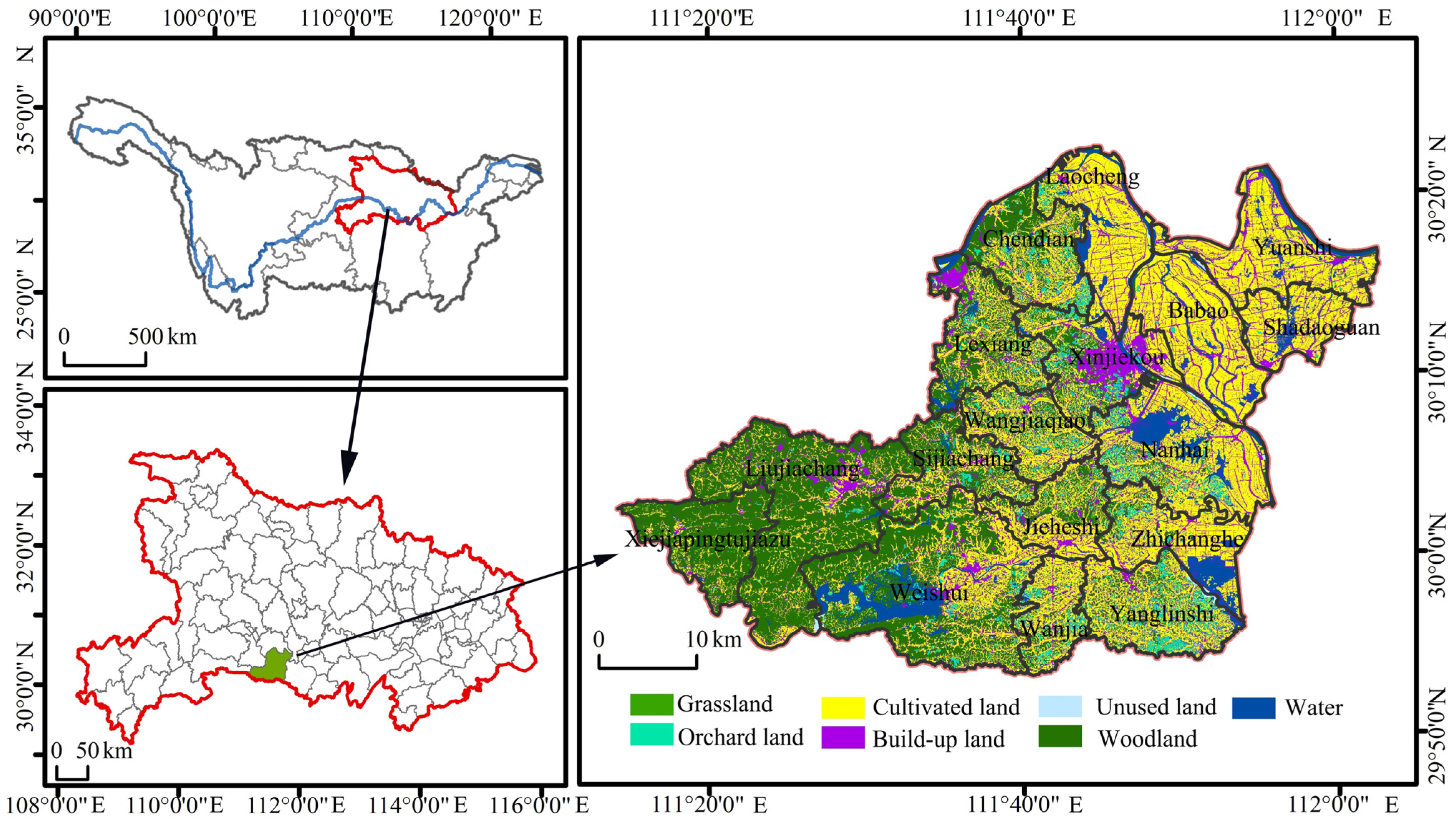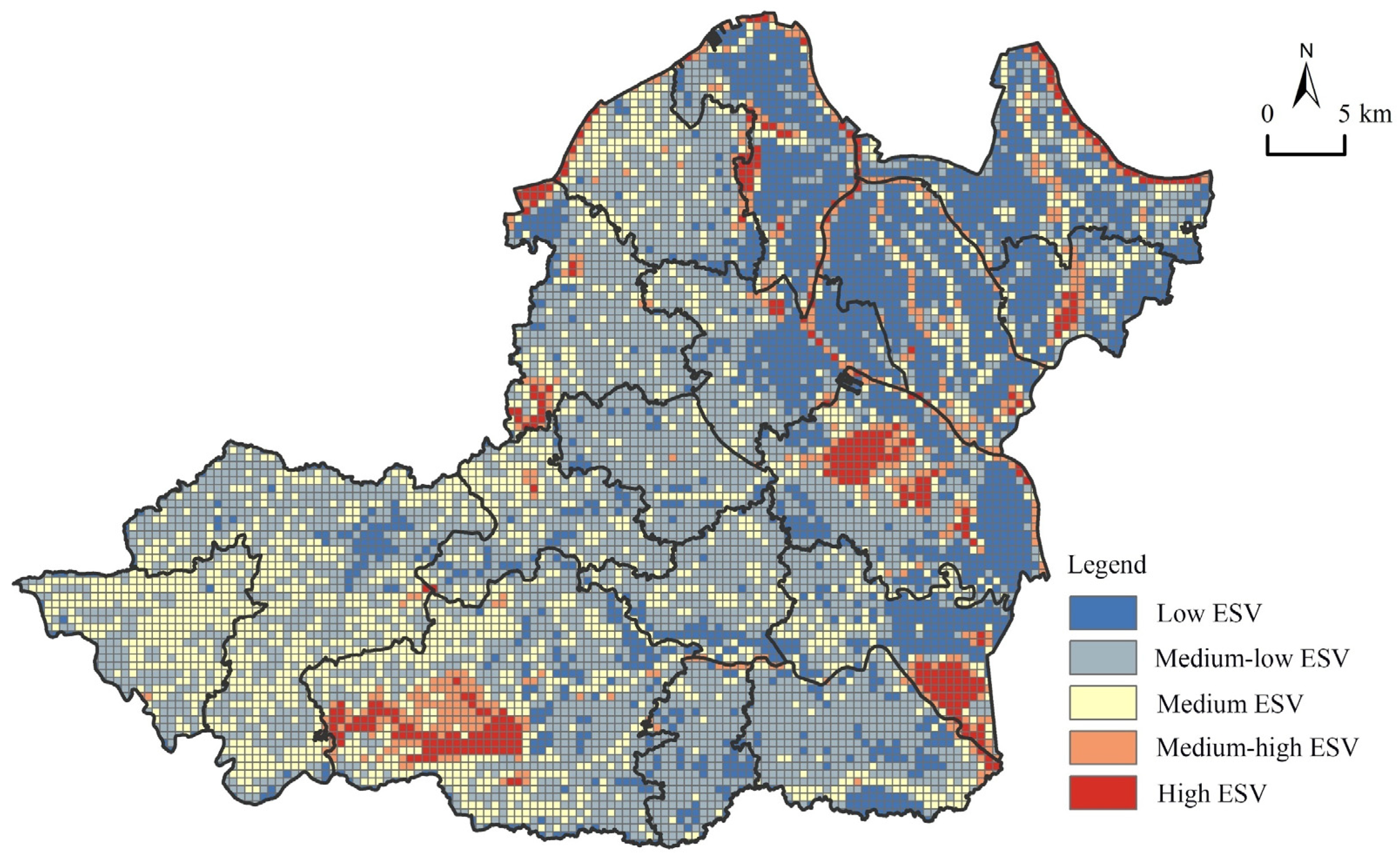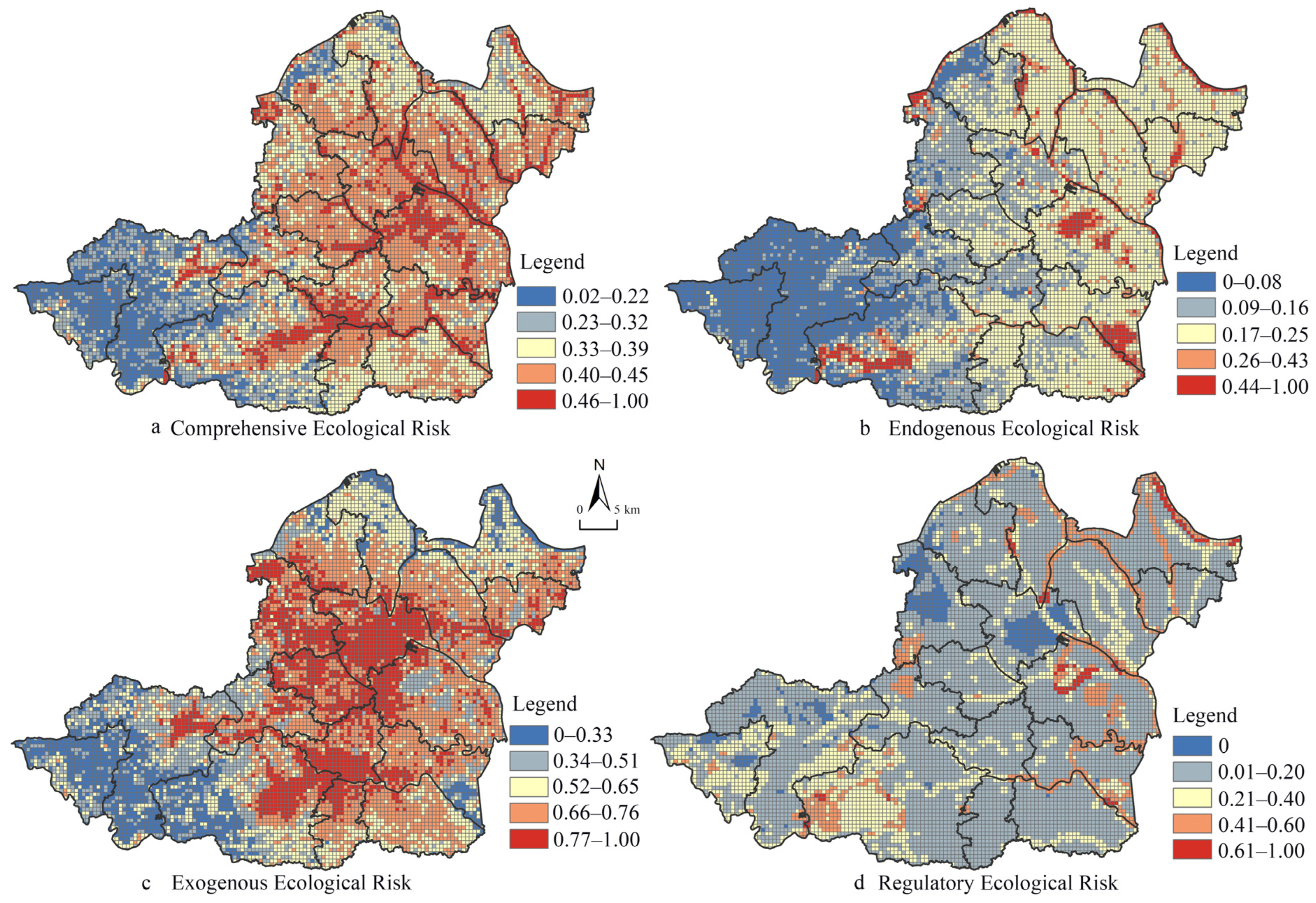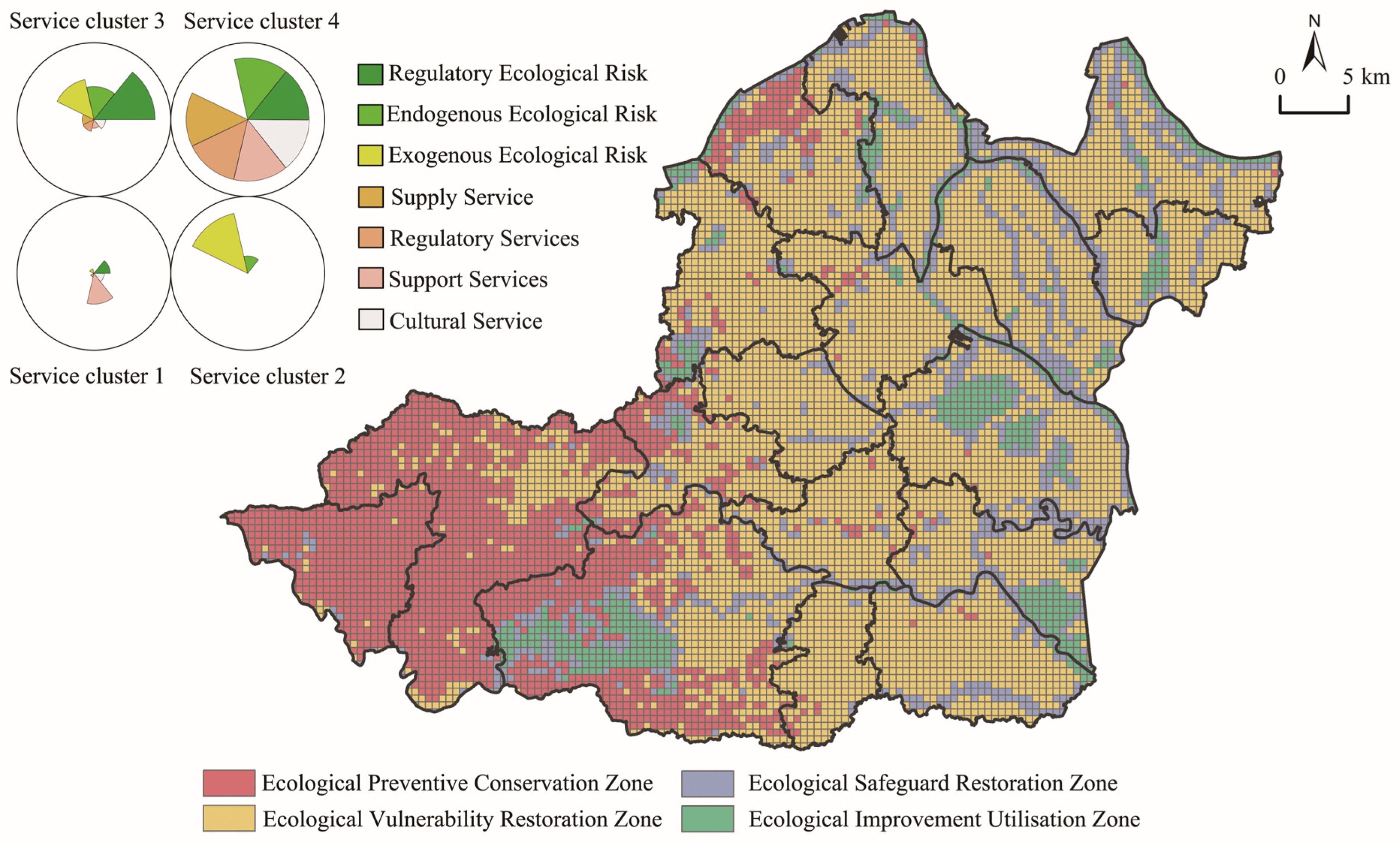Synergistic Zoning and Management Strategies for Ecosystem Service Value and Ecological Risk at the County Level: A Case Study of Songzi City, Hubei Province, China
Abstract
1. Introduction
2. Materials and Methods
2.1. Study Area
2.2. Data Sources
2.3. Methods
2.3.1. Ecosystem Service Value Estimation
2.3.2. Comprehensive Ecological Risk Assessment
- (1)
- Endogenous Ecological Risk
- (2)
- Exogenous Ecological Risk
- (3)
- Regulatory Ecological Risk
- (4)
- Comprehensive Ecological Risk Index
2.3.3. Ecosystem Service Cluster Identification
3. Results
3.1. Ecosystem Service Value Assessment
3.2. Comprehensive Ecological Risk Index Identification
3.3. Zoning-Based Ecological Management Strategies
4. Discussion
4.1. Comprehensive Assessment of Multi-Dimensional Ecological Risks
4.2. Refinement of Ecological Management Frameworks at the County Level
4.3. Limitations and Future Study Directions
5. Conclusions
Author Contributions
Funding
Data Availability Statement
Conflicts of Interest
References
- Qiu, J.J.; Liu, Y.H.; Yuan, L.; Chen, C.J.; Huang, Q.Y. Research progress and prospect of the interrelationship between ecosystem services and human well-being in the context of coupled human and natural system. Prog. Geogr. 2021, 40, 1060–1072. [Google Scholar] [CrossRef]
- Zhang, Y.W.; Su, T.; Zhang, F.G.; Li, K.; Liu, X.H. Conception and framework of land ecological restoration for a new stage in China. Chin. J. Appl. Ecol. 2021, 32, 1573–1580. [Google Scholar]
- Cao, Y.; Wang, J.Y.; Li, G.Y. Ecological Restoration for Territorial Space: Basic Concepts and Foundations. Chin. Land Sci. 2019, 33, 1–10. [Google Scholar]
- Wang, C.; Wu, X.; Fu, B.J.; Han, X.G.; Chen, Y.N.; Wang, K.L.; Zhou, H.K.; Feng, X.Y.; Li, Z.S. Ecological restoration in the key ecologically vulnerable regions: Current situation and development direction. Acta Ecol. Sin. 2019, 39, 7333–7343. [Google Scholar]
- Cheng, G.; Wu, Z.B. Comprehensive Land Consolidation and Ecological Restoration of Counties. Planner 2020, 36, 35–40. [Google Scholar]
- Fu, Y.J.; Shi, X.Y. Ecological restoration zoning of county-level territorial space based on small watershed scale: A case study of the upper Fenhe River in Shanxi. J. Nat. Resour. 2023, 38, 1225–1239. [Google Scholar] [CrossRef]
- Ma, Y.B.; Zhai, T.L.; Bi, Q.S.; Chang, M.Y.; Li, L.; Ma, Z.Y.; Li, Y.C. Ecological management zoning in the Yellow River Basin based on hierarchy of needs theory and ecosystem services supply and demand. Acta Ecol. Sin. 2024, 44, 6513–6526. [Google Scholar]
- Fu, B.J.; Chen, L.D.; Liu, G.H. The objectives, tasks and characteristics of China ecological regionalization. Acta Ecol. Sin. 1999, 19, 591–595. [Google Scholar]
- Bailey, R.G. Delineation of Ecosystem Regions. Environ. Manag. 1983, 7, 365–373. [Google Scholar] [CrossRef]
- Sadeghi, S.H.; Chamani, R.; Zabihi, S.M.; Tavosi, M.; Katebikord, A.; Khaledi, D.A.; Moosavi, V.; Sadeghi, P.S.; Vafakhah, M.; Moradi, R.H. Watershed Health and Ecological Security Zoning Throughout Iran. Sci. Total Environ. 2023, 905, 167123. [Google Scholar] [CrossRef]
- Sarker, S.; Rahman, M.J.; Rahman, M.M.; Akter, M.; Rahman, M.S.; Wahab, M.A. MPA Zoning Integrating Socio-Ecological Data in the South East Coast of Bangladesh. Mar. Policy 2021, 133, 104736. [Google Scholar] [CrossRef]
- Raj, A.; Sharma, L.K. Spatial E-PSR Modelling for Ecological Sensitivity Assessment for Arid Rangeland Resilience and Management. Ecol. Model. 2023, 478, 110283. [Google Scholar] [CrossRef]
- Jiang, X.; Jiang, Z.Y.; Zeng, Y.Y.; Wu, M.D.; Huang, Z.W.; Huang, Q. Integrating Land-Sea Coordination Into Construction of an Ecological Security Pattern for Urban Agglomeration: A Case Study in the Guangdong-Hong Kong-Macao Greater Bay Area. Environ. Sci. Pollut. Res. 2024, 31, 2671–2686. [Google Scholar] [CrossRef]
- Feng, L.; Lei, G.P. Study on Spatial-temporal Evolution Characteristics and Functional Zoning of Ecosystem Services and Trade-offs/Synergies Relationships in Northeastern China. China Land Sci. 2023, 37, 100–113. [Google Scholar]
- Zhao, X.Q.; Xu, Y.F.; Pu, J.W.; Tao, J.Y.; Chen, Y.J.; Huang, P.; Shi, X.Y.; Ran, Y.J.; Gu, Z.X. Achieving the Supply-Demand Balance of Ecosystem Services through Zoning Regulation Based On Land Use Thresholds. Land Use Pol. 2024, 139, 107056. [Google Scholar] [CrossRef]
- Li, J.L.; Hu, D.W.; Wang, Y.Z.; Chu, J.L.; Yin, H.W.; Ma, M. Study of Identification and Simulation of Ecological Zoning through Integration of Landscape Ecological Risk and Ecosystem Service Value. Sustain. Cities Soc. 2024, 107, 105442. [Google Scholar] [CrossRef]
- Liang, S.H.; Li, W.; Gao, Y.; Liu, B.Z. Correlations between ecosystem service value and landscape ecological risk and its spatial heterogeneity in Jilin Province, China. Chin. J. Appl. Ecol. 2024, 35, 769–779. [Google Scholar]
- Qiao, B.; Cao, X.Y.; Sun, W.J.; Gao, Y.Y.; Chen, Q.; Yu, H.Y.; Wang, Z.; Wang, N.A.; Cheng, H.Y.; Wang, Y.P.; et al. Ecological zoning identification and optimization strategies based on ecosystem service value and landscape ecological risk: Taking Qinghai area of QilianMountain National Park as an example. Acta Ecol. Sin. 2023, 43, 986–1004. [Google Scholar]
- Peng, J.; Dang, W.X.; Liu, Y.X.; Zong, M.L.; Hu, X.X. Review on landscape ecological risk assessment. Acta Geogr. Sin. 2015, 70, 664–677. [Google Scholar] [CrossRef]
- Zhu, Q.; Cai, Y.L. Assessment framework and simulation prediction for ecological security based on “risk-health-services”: A case study of the Huaihe River Basin. J. Nat. Resour. 2024, 39, 2676–2690. [Google Scholar] [CrossRef]
- Jia, Y.Y.; Tang, X.L.; Ren, Y.J. Spatial-temporal evolution and correlation analyses of ecosystem service values and landscape ecological risks in Anhui section of the Yangtze River basin. J. Nanjing For. Univ. 2022, 46, 31–40. [Google Scholar]
- Xie, Y.C.; Zhang, S.X.; Lin, B.; Zhao, Y.J.; Hu, B.Q. Spatial zoning for land ecological consolidation in Guangxi based on the ecosystem services supply and demand. J. Nat. Resour. 2020, 35, 217–229. [Google Scholar]
- Xie, L.X.; Bai, Y.P.; Che, L.; Qiao, F.W.; Sun, S.S.; Yang, X.D. Construction of ecological zone based on value-risk ecological function area in the Upper Yellow River. J. Nat. Resour. 2021, 36, 196–207. [Google Scholar] [CrossRef]
- Zhang, W.; Long, N.; Li, S.G.; Wang, L. Zoning of Territorial Space for Ecological Restoration Based on Potential Ecological Background Pattern Framework: A Case Study of the Guangdong-Hong Kong-Macao Greater Bay Area. Trop. Geogr. 2024, 44, 212–225. [Google Scholar]
- Yang, Q.Y.; Zhang, H.Z.; Tang, Q. Ecological restoration zoning of territorial space in Chongqing City based on adaptive cycle model. Acta Geogr. Sin. 2022, 77, 2583–2598. [Google Scholar]
- Kang, Z.W.; Zhang, Z.Y.; Wei, H.; Liu, L.; Ning, S.; Zhao, G.N.; Wang, T.X.; Tian, H. Landscape ecological risk assessment in Manas River Basin based on land use change. Acta Ecol. Sin. 2020, 40, 6472–6485. [Google Scholar]
- Wang, F.; Ye, C.S.; Hua, J.Q.; Li, X. Coupling relationship between urban spatial expansion and landscape ecological risk in Nanchang City. Acta Ecol. Sin. 2019, 39, 1248–1262. [Google Scholar]
- Xie, G.D.; Zhen, L.; Lu, C.X.; Xiao, Y.; Che, C. Expert Knowledge Based Valuation Method of Ecosystem Services in China. J. Nat. Resour. 2008, 23, 911–919. [Google Scholar]
- Cui, W.L.; Xi, H.H.; Cai, L.; Chen, M.Y.; Xu, C.L. Spatial and Temporal Change of Ecosystem Service Value in China’s Island Counties Base on NDVI. Econ. Geogr. 2021, 41, 184–192, 224. [Google Scholar]
- Xie, G.D.; Zhang, C.X.; Zhang, L.M.; Chen, W.H.; Li, S.M. Improvement of the Evaluation Method for Ecosystem Service Value Based on Per Unit Area. J. Nat. Resour. 2015, 30, 1243–1254. [Google Scholar]
- Li, X.Y. Research Progress and Trend of Integration of Chinese Cultural Industry and Tourism Industry: Based on Catespace Analysis. Econ. Geogr. 2019, 39, 212–220. [Google Scholar]
- Hu, Y.; Chen, X.; Zhao, G.; Liu, X.; Yu, J.; Li, M.; Liu, Y.; Hu, X.; Zhong, R.; Chen, Y. Ecosystem Service Responses to Land Use Change in Southern Guangzhou—The Practice of Applying Natural Resources Integrated Database for Research. Land 2022, 11, 1012. [Google Scholar] [CrossRef]
- Zhang, X.X.; Jin, X.B.; Liang, K.Y.; Han, B.; Wang, S.L.; Zhu, W.H.; Liang, X.Y.; Zhou, Y.K. Ecological risk assessment and management zoning in rapid urbanization areas from the perspective of social-ecological system: A case study of Jiangsu Province. Acta Ecol. Sin. 2024, 44, 8138–8149. [Google Scholar]
- Liu, R.J.; Pu, L.J.; Zhu, M.; Huang, S.H.; Jiang, Y. Coastal Resource-Environmental Carrying Capacity Assessment: A Comprehensive and Trade-Off Analysis of the Case Study in Jiangsu Coastal Zone, Eastern China. Ocean. Coast. Manag. 2020, 186, 105092. [Google Scholar] [CrossRef]
- Zhang, X.; Gu, R.X. Spatio-temporal pattern and multi-scenario simulation of land use conflict: A case study of the Yangtze River Delta urban agglomeration. Geogr. Res. 2022, 41, 1311–1326. [Google Scholar]
- Ai, M.S.; Chen, X.; Yu, Q. Spatial Correlation Analysis Between Human Disturbance Intensity (HDI) and Ecosystem Services Value (ESV) in the Chengdu-Chongqing Urban Agglomeration. Ecol. Indic. 2024, 158, 111555. [Google Scholar] [CrossRef]
- Liu, F.; Yan, H.M.; Liu, J.Y.; Xiao, X.M.; Qin, Y.W. Spatial pattern of land use intensity in China in 2000. Acta Geogr. Sin. 2016, 71, 1130–1143. [Google Scholar]
- Ma, Z.Y.; Li, P.; Xiao, L.; Wang, B.; Xu, Y.T.; Pan, J.J. Identification of Key Areas for Ecological Restoration and Division of Restoration Zones in Qinghai Province. J. Soil Water Conserv. 2024, 38, 252–265. [Google Scholar]
- Yan, X.L.; Li, X.Y.; Liu, C.H.; Li, J.W.; Zhong, J.Q. Spatial evolution trajectory of ecosystem service bundles and its social-ecological driven by geographical exploration: A case study of Dalian. Acta Ecol. Sin. 2022, 42, 5734–5747. [Google Scholar]
- Kohonen, T. Self-organized formation of topologically correct feature maps. Biol. Cybern. 1982, 43, 59–69. [Google Scholar] [CrossRef]
- Xia, H.; Yuan, S.F.; Prishchepov, A.V. Spatial-Temporal Heterogeneity of Ecosystem Service Interactions and their Social-Ecological Drivers: Implications for Spatial Planning and Management. Resour. Conserv. Recycl. 2023, 189, 106767. [Google Scholar] [CrossRef]
- Zhang, X.M.; Xie, B.G.; Zhou, K.C.; Li, J.H.; Yuan, C.; Xiao, J.Y.; Xie, J. Mapping ecosystem service clusters and exploring their driving mechanisms in karst peak-cluster depression regions in China. Ecol. Indic. 2024, 156, 111524. [Google Scholar] [CrossRef]
- Xu, G.Y.; Xiong, K.N.; Shu, T.; Shi, Y.J.; Chen, L.S.; Zheng, L.L.; Fan, H.X.; Yang, Z.H. Bundling evaluating changes in ecosystem service under karst rocky desertification restoration: Projects a case study of Huajiang-Guanling, Guizhou province, Southwest China. Environ. Earth Sci. 2022, 81, 302. [Google Scholar] [CrossRef]
- Gong, J.; Cao, E.J.; Xie, Y.C.; Xu, C.X.; Li, H.Y.; Yan, L.L. Integrating Ecosystem Services and Landscape Ecological Risk Into Adaptive Management: Insights From a Western Mountain-Basin Area, China. J. Environ. Manag. 2021, 281, 111817. [Google Scholar] [CrossRef]
- Li, S.Z.; Yan, Z.F.; Fu, W.Q.; Yang, Y.F.; Feng, C.L. Technical Framework of Ecological Risk Assessment and its Application in Environmental Management. Environ. Eng. 2019, 37, 181–191. [Google Scholar]
- Zhou, S.; Ou, Z.R.; Zhang, J.M.; Dong, L.M.; Li, X.F.; Deng, Z.H.; Sun, Y.Y.; Qiu, X.T. Temporal and Spatial Variations in Landscape Pattern–Function Risk Coupling Over 20 Years in the Dry–Hot Valley of the Jinsha River in China. Land 2024, 13, 2068. [Google Scholar] [CrossRef]
- Zeng, J.; Cui, X.Y.; Chen, W.X.; Yao, X.W. Ecological management zoning based on the supply-demand relationship of ecosystem services in China. Appl. Geogr. 2023, 155, 102959. [Google Scholar] [CrossRef]
- Zhong, F.M.; Chen, Z.A. Impacts of human disturbances on the supply and demand of ecosystem services in the middle reaches of Yangtze River urban agglomeration across multiple scales. Chin. J. Appl. Ecol. 2025, 36, 271–283. [Google Scholar]
- Wang, Z.Y.; Shi, P.J.; Zhang, X.B.; Yao, L.T.; Tong, H.L. Grid-scale-based ecological security assessment and ecological restoration: A case study of Suzhou district, Jiuquan. J. Nat. Resour. 2022, 37, 2736–2749. [Google Scholar]
- Xie, Y.Y.; Zhu, Q.C.; Bai, H.; He, H.Z.; Zhang, Y.A. Combining ecosystem service value and landscape ecological risk to subdivide the riparian buffer zone of the Weihe River in Shaanxi. Ecol. Indic. 2024, 166, 112424. [Google Scholar] [CrossRef]




| Land Use Type | ESV/Billion CNY | Proportion/% | Unit Area ESV Million CNY per km2 |
|---|---|---|---|
| Cultivated land | 1.36 | 17.80% | 1.51 |
| Orchard land | 0.25 | 3.35% | 2.87 |
| Woodland | 2.26 | 29.61% | 3.53 |
| Grassland | 0.01 | 0.07% | 2.21 |
| Water | 3.75 | 49.17% | 15.69 |
| Build-up land | — | — | — |
| Unused land | — | — | — |
| Total | 7.64 | 100% | 3.50 |
| Main Type | Minor Type | ESV/Billion CNY | Proportion/% |
|---|---|---|---|
| Supply service | Food production | 1.36 | 17.85% |
| Raw material production | 0.33 | 4.38% | |
| Water supply | −0.34 | −4.45% | |
| Regulatory services | Gas regulation | 0.42 | 5.51% |
| Climate regulation | 0.71 | 9.39% | |
| Purify environment | 0.32 | 4.25% | |
| Hydrological regulation | 2.62 | 34.36% | |
| Support services | Soil conservation | 0.38 | 5.00% |
| Maintenance of nutrients | 0.05 | 0.73% | |
| Biodiversity | 0.39 | 5.14% | |
| Cultural service | Aesthetic Landscape | 1.36 | 17.84% |
| Total | 7.64 | 100.00% |
| Type of Zoning Control | Service Cluster Type | Restoration Objects | Restoration Goals |
|---|---|---|---|
| Ecological Preventive Conservation Zone | Service cluster 1 | Woodlands | Maintenance of ecosystem integrity and stability |
| Ecological Vulnerability Restoration Zone | Service cluster 2 | Cultivated and built-up land | Agricultural security, habitat improvement |
| Ecological Safeguard Restoration Zone | Service cluster 3 | Rivers and surroundings | Water ecosystem restoration and management |
| Ecological Improvement and Utilization Zone | Service cluster 4 | Reservoirs, lakes, and Yangtze River shoreline | Realization of ecological product value |
Disclaimer/Publisher’s Note: The statements, opinions and data contained in all publications are solely those of the individual author(s) and contributor(s) and not of MDPI and/or the editor(s). MDPI and/or the editor(s) disclaim responsibility for any injury to people or property resulting from any ideas, methods, instructions or products referred to in the content. |
© 2025 by the authors. Licensee MDPI, Basel, Switzerland. This article is an open access article distributed under the terms and conditions of the Creative Commons Attribution (CC BY) license (https://creativecommons.org/licenses/by/4.0/).
Share and Cite
Han, T.; Luo, J.; Gan, Y.; Sun, Y.; Tian, L. Synergistic Zoning and Management Strategies for Ecosystem Service Value and Ecological Risk at the County Level: A Case Study of Songzi City, Hubei Province, China. Land 2025, 14, 1021. https://doi.org/10.3390/land14051021
Han T, Luo J, Gan Y, Sun Y, Tian L. Synergistic Zoning and Management Strategies for Ecosystem Service Value and Ecological Risk at the County Level: A Case Study of Songzi City, Hubei Province, China. Land. 2025; 14(5):1021. https://doi.org/10.3390/land14051021
Chicago/Turabian StyleHan, Tingting, Jing Luo, Yilin Gan, Yaru Sun, and Lingling Tian. 2025. "Synergistic Zoning and Management Strategies for Ecosystem Service Value and Ecological Risk at the County Level: A Case Study of Songzi City, Hubei Province, China" Land 14, no. 5: 1021. https://doi.org/10.3390/land14051021
APA StyleHan, T., Luo, J., Gan, Y., Sun, Y., & Tian, L. (2025). Synergistic Zoning and Management Strategies for Ecosystem Service Value and Ecological Risk at the County Level: A Case Study of Songzi City, Hubei Province, China. Land, 14(5), 1021. https://doi.org/10.3390/land14051021





